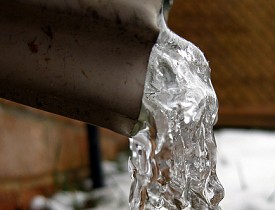Preventing Frozen Pipes (and What to Do if Your Pipes Are Frozen)

How Cold Does it Have to Be for Pipes to Freeze?
In early December, the temperature in Jacksonville, Fla., hit a record low of 21 degrees Fahrenheit, roughly the temperature that should start to cause concerns about frozen pipes. On the same day in Minneapolis, the low was 8 degrees.
Still, frozen pipes may have been a bigger concern in Jacksonville, where homeowners are less prepared and homes are less likely to be adequately designed for freezing temperatures. Exposed pipes are most vulnerable to freezing. Pipes near exterior walls or in poorly insulated crawl spaces, basements and attics are also likely to freeze.
The Building Research Council at the University of Illinois determined that uninsulated pipes in an unconditioned attic are likely to start freezing at about 20 degrees Fahrenheit, but drafty gaps and cracks can lead to frozen pipes at higher temperatures. The wind chill effects that make temperatures feel colder also contribute to freezing pipes, according to University of Illinois researchers.
It takes a few simple upgrades and some common sense to keep pipes from bursting and causing expensive headaches, particularly in climates where freezing temperatures are rare but possible. To help prevent burst pipes, drain or insulate plumbing, reduce water pressure and minimize exposure to the elements. Carefully thaw frozen pipes, and be prepared so you can minimize damage if frozen pipes burst.
Drain Exterior Pipes
- In any area subject to even occasional freezing temperatures, swimming pools and sprinkler lines should be drained before the first freeze. Don’t put antifreeze in the lines, as antifreeze is toxic and environmentally damaging.
- Detach outside hoses and close inside valves to the exposed hose bib, then open the hose bib to let any remaining water drain.
- If you are leaving for an extended period during the winter, consider draining the entire water system for your house. Shut off the water main, then open all taps and fixtures until the water drains out of the system.
Insulate Interior Pipes
- The best way to protect other vulnerable pipes is with insulation. Caulk and seal any gaps and cracks in the house, and add insulation to crawl spaces, attics and other areas that may lack insulation.
- You can also insulate pipes with thick pipe sleeves, available at plumbing supply stores and specialty insulation suppliers. Heat tape and heat cable is also available.
- For a cheap, temporary insulation fix to protect against a once-a-year freeze, tape some newspaper around the pipes.
Keep Pipes Warm
Interior pipes are often overlooked, but the pipes to your kitchen sink are likely among the most vulnerable, as they are closest to an exposed exterior wall. Keep cabinet doors open during cold snaps to avoid freezing these pipes.
If you are going to be away during a cold snap, you might be tempted to turn off the heat to save some money on utility bills. However, the plumbing bill after a frozen pipe will more than offset any potential savings. Instead, turn down the heat to save some energy but leave it above 55 degrees.
Consider asking a neighbor to check on your house regularly while you are away to make sure the power or fuel supply didn’t shut off and leave your house vulnerable to freezing.
Reduce Pressure in Pipes
Frozen pipes typically burst because excessive water pressure builds up between the faucet and a chunk of ice in the pipe. A slow drip will relieve this pressure.
- Let water drip from faucets with exposed pipes, such as the kitchen sink. A slow drip won’t necessarily keep a pipe from freezing, but it could keep a frozen pipe from bursting. Again, this wastes a little bit of water (and energy, in the case of hot water lines), but the added cost is far less than the potential plumbing bill. Remember, you can capture and use the dripping water.
Thawing Frozen Pipes
- Step 1: Check and turn off the water main: Before the temperatures drop, find your water main and learn how to shut if off. If you turn on a faucet and there is no water, you may have a burst water main. In that case, shut off the main and call a plumber. Then start investigating the plumbing for cracked pipes and pooled water.
- Step 2: Find the problem spot: If you get a trickle of water, the pipe is likely frozen. Leave the tap on and try to thaw the pipe, starting near the faucet. If you leave the tap on, flowing water will help thaw the blockage, and is a good indicator you found the problem spot.
- Step 3: Thaw it out: You can thaw pipes with an electric heating pad, hot soaked towels or an electric hair dryer. Never use an open flame, as you are liable to damage the pipes, start a fire or generate dangerous carbon monoxide poisoning.
Remember that water only has to freeze once to burst a pipe. In any area subject to even occasional freezing temperatures, protect pipes from freezing, minimize pressure in cold pipes and thaw frozen pipes before they burst.
Looking for a Pro? Call us (866) 441-6648

Plumbing Average Costs
Plumbers Experiences

Fast Hot Water Heater Replacement ... On A Weekend!

Kitchen Faucet Replacement With A Unique New Feature



